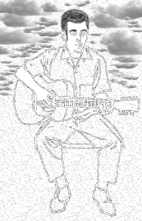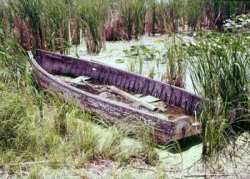 |
 |
| Home | Welcome | What's New | Site Map | Glossary | Weather Doctor Amazon Store | Book Store | Accolades | Email Us |
 | |||||||||||||||||||||||||||||||||||||||||||||||||||||||||||||||||||||||||||||||||||||||||||||||||||||||||||||||||||||||||||||||||||||||||||||||||||||||||||||||||||||||||
Weather Almanac for February 2003SINGING IN THE RAIN...AND SNOW AND WIND
Weather events large and small have long inspired the creativity of poets and painters, novelists and composers. Perhaps their inspiration comes from primal stirring with their breasts as weather swirls around them. And what more compelling way can artists draw our attention to their works than by using common themes that stir all of us? Today, the memory of howling winds on such a winter's day, pulled from my mind's treasure chest, replayed in my head. A long time has passed since I heard such weather music live in concert. My weather sounds today are more limited and indirect, the whine and sizzle of traffic speeding along wet pavement. I often bemoan the limited repertoire of Victoria weather sensations and long for the sensual stimulus of my beloved Great Lakes weather: the sights, the feel, the sounds. Therefore, I often take advantage of my readily available library of natural sounds on tape and CD. They return to me the memories of rumbling, cracking thunder, the rustle of wind through autumn leaves, and the patter of rain. The recorded sounds of winter, however, are more rare: the howl of the wind, the squeak of snow underfoot, the hiss of snow and ice crystals galed across icy fields. This is the time I turn to the work's of some of the classical composers — in this particular instance, Vaughan Williams and his Sinfonia Antarctica. Williams, of course, is not the only composer in the classical music genre to produce evocative sound poems based on the weather. Most of the renown composers have scored portrayals of melodious skyscapes: Beethoven, Berlioz, Debussy, Grofé, Moussorgsky, Strauss, Vivaldi, Wagner — to name just a few. And song writers from the common people to professional songsmiths have used the weather to create images and tell stories and celebrate life in their works. Though weather inspires all artists, today I focus on the tonal expression of weather through instrumental renditions and song lyrics. The music is rising in my soul. So, let's start with an exercise. Sit back, relax, close your eyes, and think of those weather-based musical connections that most stir you. Did The Rain in Spain fall somewhere on the plain? Were you transported Somewhere Over the Rainbow? Or did you wish to Let It Snow, Let It Snow, Let It Snow? Did you Call the Wind Maria? Were you Singing in the Rain? Or wishing for a Heat Wave? For me? Well, Baby, The Rain Must Fall reigns high. And I listened for The Wayward Wind and the Rhythm of the Rain as I Cast My Fate to the Wind and await Canadian Sunset.
[I regret I cannot give you clips of each of these songs, but space and copyright laws tie my hands. Most are fairly well known, however, and can be found at libraries and music stores as well as on the web. I have linked a few to recordings available through Amazon.com (many have audio clips) so just click on the link to purchase them. A number of the featured pieces can be found on the CDs Thunder & Lightning and Thunderous Classics.] Classical MusicClassical instrumental works from sonatas to symphonies have sought to set a weather mood in the listener. Some, like the "Cloudburst" movement from Ferde Grofé's Grand Canyon Suite, are obvious from the first hearing. Others reveal themselves only when a hint is given through other sources, perhaps the title. I personally am indebted to Disney's Fantasia and Silly Symphonies for opening me to a variety of classical pieces that were related to weather such as Claude Debussy's Noctures and Modest Moussorgsky's Night on Bald Mountain. Perhaps the most extensive single work devoted to weather scenes is Antonio Vivaldi's The Four Seasons. Each piece in this 18th century quartet of concertos paints a seasonal picture through typical weather events and human activities. Most amusing is the introduction to the fourth concerto Winter which depicts with rapid string notes the shivering and chattering of teeth as the cold weather sinks in. The power and sounds of thunderstorms are prime for rendition into music, allowing the bass instruments their day in the sun. The natural crash, bang and boom of thunder and power of the convective storm link with our emotional response to make the thunderstorm particularly interesting to the composer. Grofé's "Cloudburst" movement is one of the best in my opinion. Others depicting thunderstorms include:
Larger storms are depicted in "The Ride of the Valkyries," the introduction to the third act of Richard Wagner's opera Die Walkure. Here, the daughters of Wotan gather on a storm-ravaged mountain peak hammered with Donar's thunder and lightning. Modest Moussorgsky's Night on Bald Mountain is another stormy mountain peak piece mixing wild weather and witchcraft in its allusions. Not all classical weather music is stormy, however. Grofé begins and ends the Grand Canyon Suite with the glories of sunrise and sunset over the great canyon. In a similar vein, Edvard Grieg opens the Peer Gynt Suite (No. 1) with a glorious Morning movement that makes me long for those passionate hours of new day light. Fair weather is depicted in Nikolay Rimsky-Korsakoff's The Flight of the Passing Clouds and Claude Debussy's "Nuages" movement from his Nocturnes suite. I hear similar scenes of fair night weather in his Clair de Lune and Beethoven's Moonlight Sonata. Debussy has also given us La Mer in which the interplay of wind and sea are painted in "Dialogue du Vent et de La Mer" (The Dialogue of the Wind and the Sea). CLASSICAL WEATHER MUSIC
Folk and Country MusicThe music of the common folk (and it commercial use) often speaks of weather's impact on daily life and the tragedies of violent weather. Perhaps our first exposure to music came in lullabies and infants songs extolling weather: "When the wind blows, the cradle will rock...." Then, we learned Twinkle, Twinkle, Little Star (the effect of turbulent density differences in the atmosphere) and Rain, Rain, Go Away before graduating to Jingle Bells and Frosty the Snowman. The Frozen Logger tells us a tall tale of a hardy logger who "at a hundred degrees below zero, buttoned up his vest." Wasn't That A Mighty Storm marvelled at the tragedy of the Great 1900 Galveston Hurricane — a revised version A Mighty Day became the anthem for the revival of the (Chad) Mitchell Trio. Woodie Guthrie's Dust Bowl Ballads sang of the hardships of the Great Dust Bowl years of the 1930s and propelled Guthrie into the mythology of American folk music.
I recall singing In the Good Old Summertime in grade school and hearing the line storm rage in Ghost Riders in the Sky. I always feel all comfy when Doc Watson picks Windy and Warm on his guitar. The weather poetry of the modern folk era was firmly established when Joni Mitchell sang of "rows and flows of angel hair, and ice-cream castles in the air" in Clouds (aka Both Sides Now), and Bob Dylan told us "the answer is blowin' in the wind." WEATHER-RELATED FOLK AND COUNTRY MUSIC
Jazz and Popular MusicArtists that sent the weather-related jazz and popular music pieces out over the air waves ranged from Louis Armstrong and Frank Sinatra to Judy Garland and Barbara Streisand. Bing Crosby was a pioneer in this with his mega-hit White Christmas which first stormed to the top of the charts in 1942. Recorded by many other artists as well, White Christmas is the best selling song of all time. (For more on this hit, click here.) Nat King Cole was joyful in those Lazy Hazy Crazy Days of Summer while Dean Martin exhorted us to Let it Snow. All the while, Fred Astaire was dancing and Singing in the Rain. Whether it was a Rainy Night in Georgia or there were Storms in Africa, you could find Blue Skies — Somewhere Over the Rainbow. WEATHER-RELATED JAZZ AND POPULAR MUSIC
Rock and Roll MusicWith the rock and roll era, often music turned more inwardly, but still, weather illusions prevailed. Tears became Raindrops as the Rhythm of the Rain was "telling me just what a fool I'd been." The Hazy Shade of Winter had us all California Dreaming. Then, Summer in the City drove us Up on the Roof into the Summer Breeze. While Elvis stood in Kentucky Rain and B.J. Thomas felt Raindrops Keep Fallin' on My Head, we learned It Never Rains in California! WEATHER-RELATED ROCK AND ROLL MUSIC
The Last Lyric
As I wonder Who'll Stop the Rain? I know that when it does, Sunshine On My Shoulder will make me happy. And so too do weather songs and music, Come Rain or Come Shine. Sing Out! What A Wonderful World! Written by
|
|||||||||||||||||||||||||||||||||||||||||||||||||||||||||||||||||||||||||||||||||||||||||||||||||||||||||||||||||||||||||||||||||||||||||||||||||||||||||||||||||||||||||
 |
To Purchase Notecard, |
Now Available! Order Today! | |
 |
 |
NEW! Now |
The BC Weather Book: |


